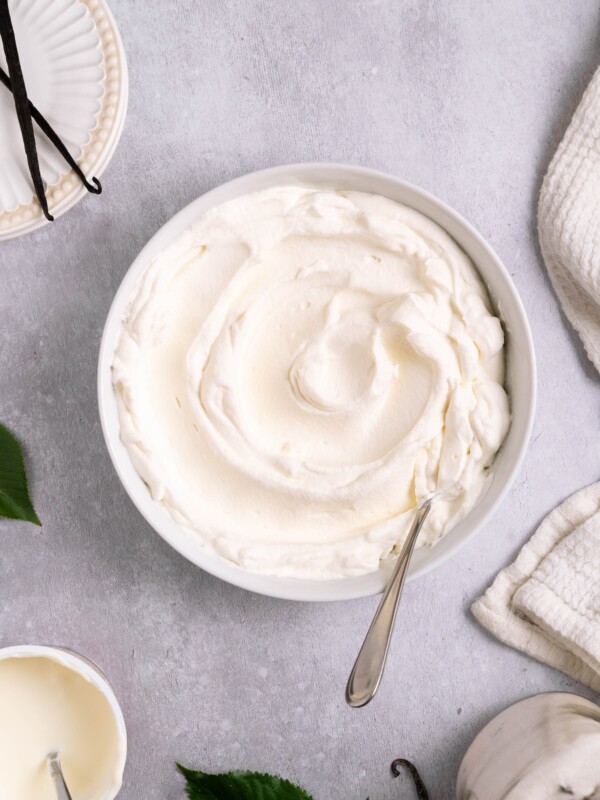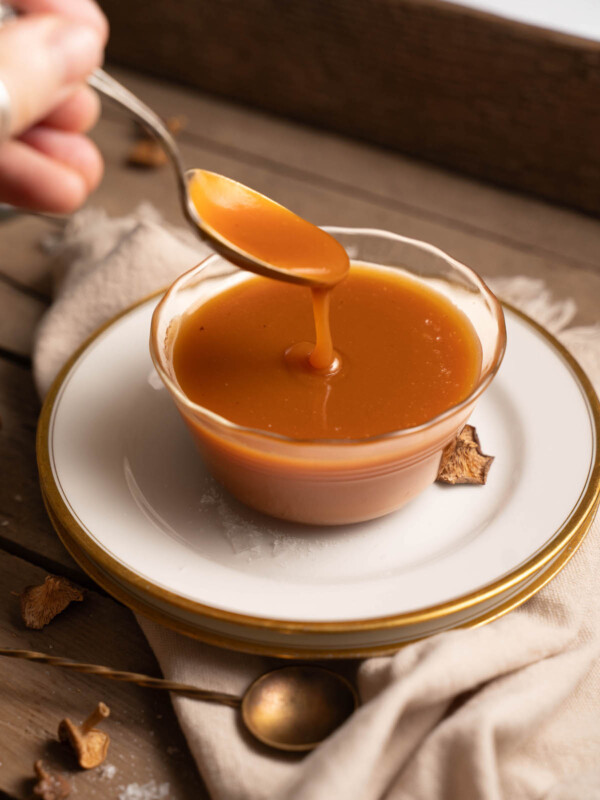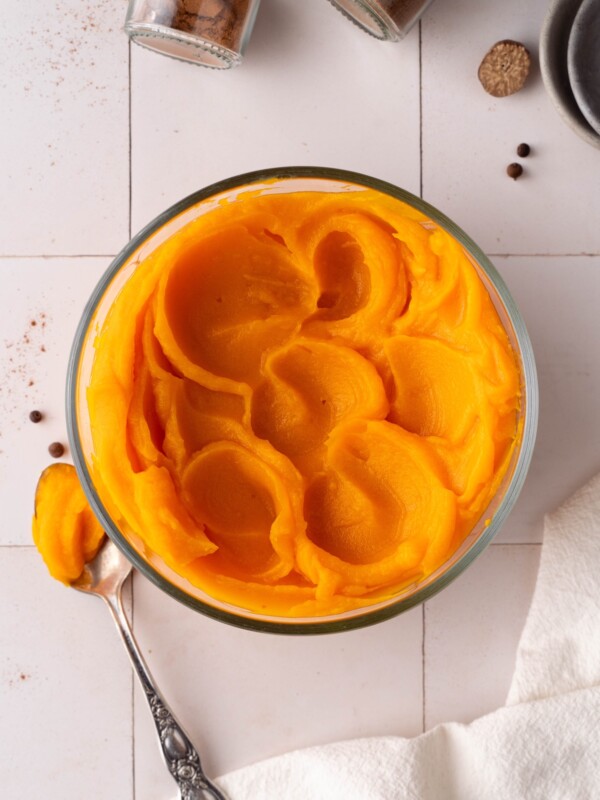
Brown Sugar Buttercream is a silky, buttery, not-too-sweet frosting that only takes about 10 minutes to make and requires just 4 ingredients. Made using the Swiss meringue method and rich dark brown sugar, it’s unbelievably smooth and fluffy, with a nostalgic taste that reminds me of butter pecan ice cream.
With toasty, caramel-y notes and a big hit of vanilla, it’s the perfect frosting to pair with your favorite fall and winter cakes and cupcakes.
Table of Contents
- Why this recipe works
- Recipe overview
- Ingredients notes & substitutions
- How to make brown sugar buttercream
- Pro tips for perfect frosting
- troubleshooting Swiss meringue buttercream
- Flavor variations
- How to use brown sugar buttercream
- Storage & make-ahead
- Brown sugar buttercream FAQs
- Brown Sugar Buttercream Recipe
Why this recipe works
- Swiss meringue method = ultra-smooth texture. Heating the egg whites and sugar before whipping dissolves the brown sugar and prevents graininess.
- Dark brown sugar = deeper flavor + natural color. The molasses in the brown sugar gives this buttercream a subtle caramel note and lovely champagne color.
- Not too sweet. I’m such a huge fan of Swiss meringue buttercream because it has a balanced sweetness that isn’t cloying. It’s the kind of frosting that’s loved by people who think they don’t like frosting.
- Only 4 ingredients. Egg whites, brown sugar, butter, and vanilla – pure and simple.
Recipe overview
⏱️ Time to make: About 10 minutes
🍴 Yield: Frosts one 8″ layer cake, 12–18 cupcakes, or a sheet cake
💪 Skill level: Beginner
😋 Flavor profile: Notes of butter, caramel, molasses, and vanilla. Pairs well with: Chocolate, vanilla, apple, spice cakes, brown butter, caramel, toasted nuts
Ingredients notes & substitutions
You only need 4 ingredients to make brown sugar buttercream!

Egg whites. Be careful not to pop the yolks when separating your eggs, as the fat in the yolks can prevent the meringue from whipping up properly, leaving it dense, flat, or unable to reach stiff, glossy peaks. (Save those yolks for another treat, like crème brûlée, mango curd, or pastry cream.)
Dark brown sugar. This gives the buttercream a lovely light brown color and delicious toffee-like flavor. Regular/light brown sugar works just fine too.
Unsalted butter. You’ll want to leave your butter out at room temperature for at least 20 minutes before using it. It should be soft and pliable, but not melty.
Vanilla extract. The higher the quality, the better. You could also use vanilla paste or even the seeds of a fresh vanilla bean instead.
How to make brown sugar buttercream
Making a Swiss meringue buttercream might sound intimidating, but I promise you it’s easier than you think. Just follow these directions and be sure to check out my tips and troubleshooting guide below.
Find the full ingredients list and detailed recipe instructions in the recipe card at the bottom of this post. Here’s a quick step-by-step overview of how to make this recipe:
- Heat the egg whites & sugar. Whisk over a double boiler until the mixture is warm and the sugar is fully dissolved.
- Whip into a glossy meringue. Beat until stiff peaks form and the mixture has cooled.
- Add the butter. Mix in the softened butter a bit at a time, until the frosting turns silky and smooth.
- Finish with vanilla. After the frosting comes together, blend in the vanilla.


Pro tips for perfect frosting
Make sure the sugar dissolves completely. If you have a digital or candy thermometer, cook the egg white & brown sugar mixture to 160° F. No thermometer? Just rub a bit of the mixture between your fingertips. If it feels grainy, keep heating and whisking until the mixture feels warm and smooth between your fingers.
Don’t rush the cooling step. Adding butter while the meringue is too warm will cause the butter to melt and the frosting to collapse or liquify. The mixer bowl should feel lukewarm to the touch. If you’re using a digital thermometer, when the mixture reaches 90° F is a perfect time to start adding butter.
👉 If it curdles, keep mixing. A meringue buttercream is essentially an emulsion, which means the ingredients blend smoothly only when they’re at similar temperatures. If the butter is too cold or the meringue too warm, the mixture can separate instead of coming together into a silky, unified frosting. But don’t worry! A broken-looking buttercream usually comes together with a few extra minutes of whipping.
Don’t add the vanilla until the buttercream is silky-smooth! Make sure you have a completely emulsified frosting before adding the vanilla, or it may be tricky to get your frosting to that lovely silky texture.
troubleshooting Swiss meringue buttercream
Is your buttercream “broken”? If you’re having trouble getting your frosting to come together, it may need to chill slightly or warm up slightly.
Does it seem melty or greasy? Chill it briefly. Pop the bowl in the fridge for 10 minutes, then try whipping again.
Does it look separated, with chunks of cold butter? Warm it back up. To re-warm, place the mixing bowl back over your double boiler, whisking often, for just a minute or two. Then place back on the stand mixer and whip again until smooth.
Flavor variations
Feel free to get creative with your brown sugar buttercream if you want to take it to the next level. Here are just a few ideas of how you can mix it up:
- Brown butter: Use solid, room temperature brown butter to give this frosting even more of those dark toffee & caramel notes.
- Maple: Add a splash of maple extract with the vanilla for extra caramel depth.
- Coffee: Add 1 teaspoon of instant espresso powder for a brown-sugar-latte vibe.
- Cinnamon: Whip 1 teaspoon of ground cinnamon in at the end for a little spice flavor (and a cute speckled look!).
- Bourbon or rum: Just a teaspoon adds a warm, cozy depth. Add at the very end.
How to use brown sugar buttercream
This frosting is incredibly versatile and pairs beautifully with fall and winter bakes, although it’s delicious all year ’round.
Try it on:
- Apple Butter Cake – the caramel notes are a perfect match
- Vanilla Cake – simple and classic
- Chocolate Cupcakes – rich chocolate + buttery brown sugar = dreamy
- Gingerbread Cake – a perfect pairing
- Banana Bread or Banana Cake – turn humble banana bread into a decadent dessert
- Pumpkin Cake – for all the fall vibes
- Cinnamon Rolls – for a fun twist on a classic
It’s great for piping on cupcakes, sandwiching between cookies, frosting sheet cakes, or adding a special touch to brownies.
Storage & make-ahead
Room temperature: This buttercream is fine to leave at room temperature for up to 3 days (unless your house is super warm). Keep it in an airtight container or tightly wrapped in plastic.
Refrigerator: Store in an airtight container in the fridge for up to 1 week. To re-warm, place it in a mixing bowl over a double boiler, whisking frequently for a few minutes. Then move to a stand mixer and re-whip until fluffy.
Brown sugar buttercream FAQs
This usually means there’s fat interfering with the whites. Even a tiny bit of egg yolk or grease in the bowl can prevent the meringue from whipping up properly. Start with a spotless bowl and make sure your whites are completely yolk-free.
Either the meringue was still too warm or the butter was too soft. Keep mixing—Swiss meringue buttercream often looks runny right before it comes together. If it stays loose, chill the bowl for 10–15 minutes and whip again.
This happens when the ingredients are different temperatures. Keep whipping and it should emulsify as the butter softens. If it still looks lumpy, warm the bowl slightly over a double boiler (30-60 seconds) and continue whipping until smooth.
Yes! Swiss meringue buttercream pipes beautifully. It’s soft, stable, and holds detail well without crusting over.

If you make this Brown Sugar Buttercream, please leave a star rating and let me know what you think in the comments. This helps me continue to provide free recipes!

Brown Sugar Buttercream
Equipment
- Stand mixer with whisk attachment or electric beaters
Ingredients
- 2 egg whites
- 5 ounces (⅔ cup) dark brown sugar, or regular brown sugar
- 8 ounces (1 cup) unsalted butter
- 2 teaspoons vanilla extract
Instructions
- Set up a double boiler: Fill a medium pot with 1–2 inches of water and bring to a gentle simmer over medium heat. Place a heatproof mixing bowl (glass or stainless steel) on top, making sure the bottom of the bowl does not touch the water.
- Warm the egg whites & sugar: Add 2 egg whites and ⅔ cup dark brown sugar to the mixing bowl. Whisk often, making sure to scrape down any brown sugar that creeps up the sides. Cook gently over low heat until mixture reaches 160° F on an instant-read thermometer and sugar has fully dissolved (rub a little between your fingers — there should be no gritty sugar crystals).
- Whip and cool: Remove bowl from heat and transfer to a stand mixer fitted with the whisk attachment. Whip on medium-high speed until the meringue becomes glossy, voluminous, and the mixture has cooled to about 90°F, 3-5 minutes. The bowl should feel just slightly warm to the touch.
- Add butter: With mixer on medium speed, add softened butter 1 tablespoon at a time, allowing each addition to incorporate before adding the next. The mixture may look curdled at first, but keep mixing! It will smooth into a silky buttercream eventually.
- Finish with vanilla: Add 2 tsp vanilla; beat on medium speed for 1–2 more minutes, until the buttercream is smooth, fluffy, and completely emulsified.
Notes
Did you try this recipe?
Be sure to leave a comment below!


